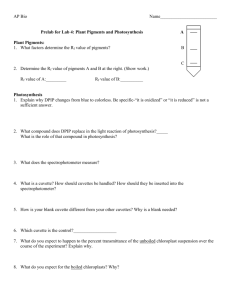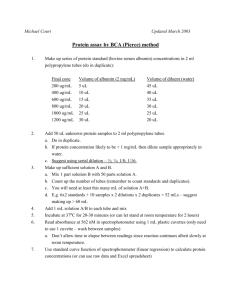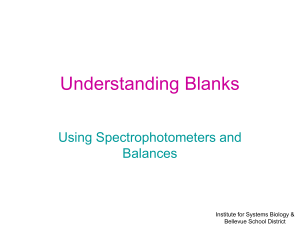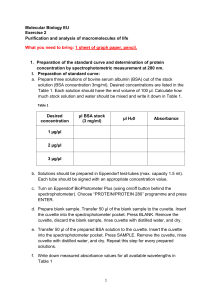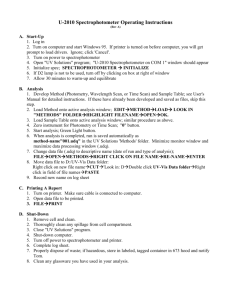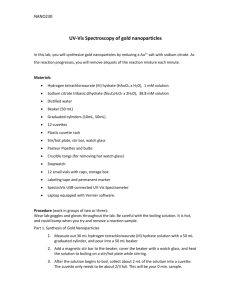Student Text spectrophotometer
advertisement
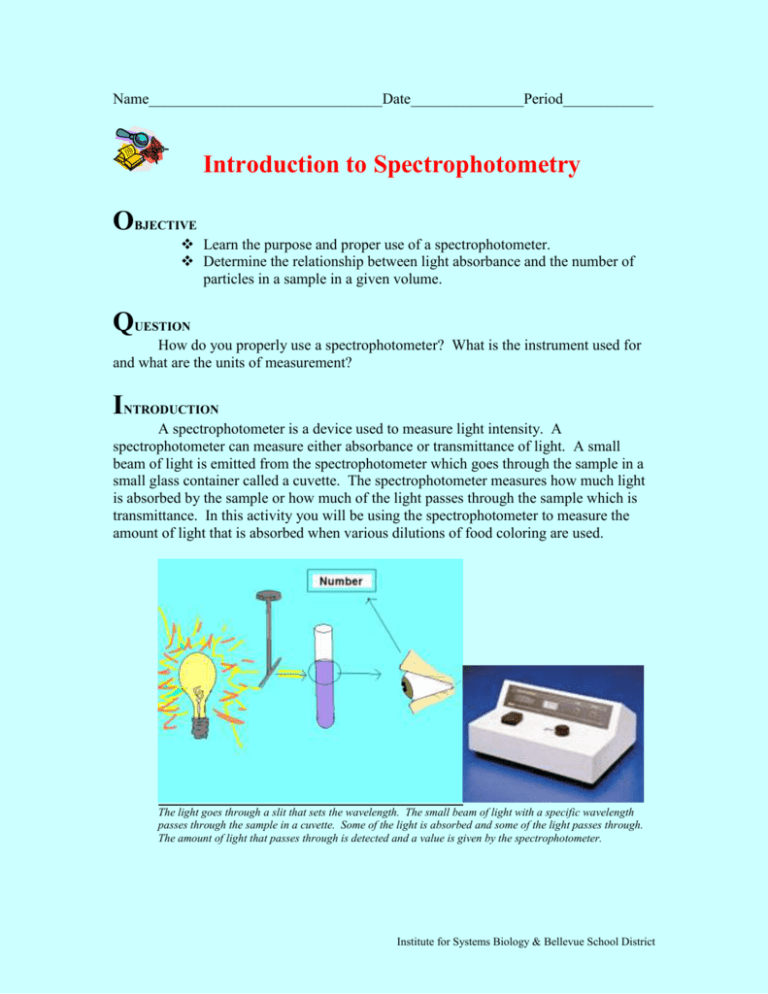
Name_______________________________Date_______________Period____________ Introduction to Spectrophotometry OBJECTIVE Learn the purpose and proper use of a spectrophotometer. Determine the relationship between light absorbance and the number of particles in a sample in a given volume. QUESTION How do you properly use a spectrophotometer? What is the instrument used for and what are the units of measurement? INTRODUCTION A spectrophotometer is a device used to measure light intensity. A spectrophotometer can measure either absorbance or transmittance of light. A small beam of light is emitted from the spectrophotometer which goes through the sample in a small glass container called a cuvette. The spectrophotometer measures how much light is absorbed by the sample or how much of the light passes through the sample which is transmittance. In this activity you will be using the spectrophotometer to measure the amount of light that is absorbed when various dilutions of food coloring are used. The light goes through a slit that sets the wavelength. The small beam of light with a specific wavelength passes through the sample in a cuvette. Some of the light is absorbed and some of the light passes through. The amount of light that passes through is detected and a value is given by the spectrophotometer. Institute for Systems Biology & Bellevue School District MATERIALS For each team of 3-4 o 1 Spectrophotometer o 4 cuvettes o 3 beakers with 25 mL of various dilutions of food coloring labeled A, B, and C o 1 beaker with 25 mL of water o 4 disposable Beral pipets o Kim wipes Beral Pipet Safety Reminders: Wear goggles at all times Don’t wear nice clothing (you might ruin it!) PROCEDURE 1. Look at Samples A, B, and C. Rank the samples based on observed color intensity from least intense to most intense. Record. 2. Use the absorbance setting at 540 nm. 3. Take a disposable Beral pipet, squeeze the bulb and then place the tip of the pipet into the water. Slowly release the bulb to draw 1 mL of water into the pipet using the graduations on the pipet. Squeeze the bulb slowly to dispense the 1 mL of water directly into a cuvette. Repeat this until you have added 4 mL of water into your cuvette. This cuvette with water will be use for comparison and is called the blank. Keep this sample throughout the entire activity because it will be your blank to zero the spectrophotometer between each reading. Always use Kim wipes to remove any fingerprints from the cuvette before putting it in the spectrophotometer. 4. Put the cuvette with water (blank) into the spectrophotometer. Press and hold the zero button (0A/100%T). The spectrophotometer will flash “BLA” for a few seconds. Wait until the spectrophotometer reads 0.000 before removing the blank. Institute for Systems Biology & Bellevue School District 5. Put 4 mL of Sample A into a clean cuvette. Put the cuvette in the spectrophotometer. Measure the absorbance by looking at the number on the screen (you do not need to press any buttons) and record. 6. Repeat Steps 4-5 with Samples B and C. 7. Clean up by pouring out samples in the sink and rinsing the cuvettes with water. Return materials to the appropriate location. RESULTS Sample A Sample B Sample C Observed Color Intensity Absorbance (O.D.U) QUESTIONS 1. What is the relationship between observed color intensity and the absorbance? 2. What would you know about two samples if one sample has higher absorbance than the other sample? 3. What is the purpose of the cuvette with water (blank) and why do we use a blank between each reading? 4. Spectrophotometers can be used to measure cell density (the number of cells per unit of volume). How would the absorbance readings on the spectrophotometer compare if you have two samples, one with very little cell growth and one with a lot of cell growth? Institute for Systems Biology & Bellevue School District

